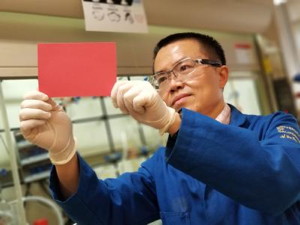Home > Press > Product authentication at your fingertips: UC Riverside-led research brings rapid and reversible switching of plasmonic color to solids
 |
| Yadong Yin is a professor of chemistry at UCR.
CREDIT Yin lab, UC Riverside |
Abstract:
Imagine if water vapor in your breath or surrounding your fingertips revealed invisible patterns on commercial products — smartphones, laptops, expensive liquor — that verified the products’ authenticity and aided anticounterfeiting efforts.
Product authentication at your fingertips: UC Riverside-led research brings rapid and reversible switching of plasmonic color to solids
Riverside, CA | Posted on October 4th, 2019
Imagine, too, if fast, stable, and reversible color switching could be easily developed in solids, opening up promising applications in color displays, signage, sensors, and information encryption.
A team led by a chemist at the University of California, Riverside, has brought this fantasy closer to reality by fabricating for the first time “plasmonic” color-switchable films of silver nanoparticles, or AgNPs. Until now, such color changing of nanoparticles was mainly achieved in liquids, limiting their potential for practical applications.
“Rapid and reversible tuning of plasmonic color in solid films, a challenge until now, holds great promise for a number of applications,” said Yadong Yin, a professor of chemistry, who led the research team. “Our new work brings plasmonic metal nanoparticles to the forefront of color-converting applications.”
Study results appear in Angewandte Chemie International Edition. The research paper has been designated a VIP paper by the journal.
Plasmonics
Plasmonic metal nanoparticles, such as gold and silver, have special optical properties because they efficiently absorb and scatter light at particular wavelengths. Their colors can be altered by changing the distance between their individual particles — a feature that Yin’s research team took advantage of to develop their plasmonic color-switching film.
The researchers coated a glass substrate with a layer of sodium borate, or borax. Then they sprayed AgNPs over the borax to form a film. Yin explained that each AgNP has capping ligands on its surface that introduce distance between the AgNPs. Without the buffer provided by the ligands, the nanoparticles would clump together.
Chemistry lesson
In the presence of water or moisture, borax turns to boric acid and releases hydroxyl ions. These ions “deprotonate” a chemical group of the ligands, resulting in the loss of a proton and the addition of a negative charge on the AgNPs. Repulsion forces push the negatively charged nanoparticles away from each other. The nanoparticles, which are pink, acquire new interparticle distances, causing them to reflect a different color: yellow.
When the moisture is removed, the boric acid converts back to borax by capturing hydroxyl ions, initiating a protonation of the ligand’s chemical group. This causes a reduction in surface charges on the ligand, weakening the repulsion forces between the AgNPs and causing them to draw closer to each other and aggregate. With interparticle distances now reduced, the color of the AgNP film switches back from yellow to pink, demonstrating full reversibility.
“Through this mechanism, we could rapidly achieve plasmonic color switching of the AgNP film in the presence or absence of moisture,” Yin said. “In our experiments, we exposed the AgNP film to moisture of 80% relative humidity and found the film changed colors from pink to red, orange, and finally yellow.”
By the fingertips
Making use of the relative humidity around human fingers — as high as 100% — Yin’s team found AgNP films can change color in response to the proximity of a fingertip.
“This allows for a convenient, rapid, and touchless method that can be used in information encryption and product authentication,” Yin said. “Various high-resolution patterns can be effectively encrypted in the AgNP films through a lithography process and then decrypted when exposed to moisture in human breath or from fingertips. Other foreseeable applications include secure communication and calorimetric real-time environment or health monitoring.”
Yin’s team found that the moisture-responsive AgNP films showed reversibility and repeatability in plasmonic color switching for more than 1,000 cycles.
###
The research was supported by a grant to Yin from the U.S. National Science Foundation. He was joined in the research by Rashed Aleisa and Ji Feng of UC Riverside; and Luntao Liu, Yun Zhang, Yiqun Zheng, and Wenshou Wang of Shandong University, China.
####
About University of California – Riverside
The University of California, Riverside is a doctoral research university, a living laboratory for groundbreaking exploration of issues critical to Inland Southern California, the state and communities around the world. Reflecting California’s diverse culture, UCR’s enrollment is more than 24,000 students. The campus opened a medical school in 2013 and has reached the heart of the Coachella Valley by way of the UCR Palm Desert Center. The campus has an annual statewide economic impact of almost $2 billion. To learn more, email .
For more information, please click here
Contacts:
Iqbal Pittalwala
951-827-6050
@UCRiverside
Copyright © University of California – Riverside
If you have a comment, please Contact us.
Issuers of news releases, not 7th Wave, Inc. or Nanotechnology Now, are solely responsible for the accuracy of the content.
News and information
![]() Neuroprosthetic and Exoskeleton Allow Tetraplegic Patient to Move October 7th, 2019
Neuroprosthetic and Exoskeleton Allow Tetraplegic Patient to Move October 7th, 2019
![]() Nanoparticles Inside Samples of Mucus to Measure COPD Development October 4th, 2019
Nanoparticles Inside Samples of Mucus to Measure COPD Development October 4th, 2019
![]() Oxford Instruments Supplies HLJ Technology Co. Ltd., with Plasma Etch and Deposition Solutions for the fabrication of VCSELS on 6 inch wafers October 3rd, 2019
Oxford Instruments Supplies HLJ Technology Co. Ltd., with Plasma Etch and Deposition Solutions for the fabrication of VCSELS on 6 inch wafers October 3rd, 2019
![]() Researchers repurpose failed cancer drug into printable semiconductor October 3rd, 2019
Researchers repurpose failed cancer drug into printable semiconductor October 3rd, 2019
Display technology/LEDs/SS Lighting/OLEDs
![]() CCNY physicists score double hit in LED research September 27th, 2019
CCNY physicists score double hit in LED research September 27th, 2019
Law enforcement/Anti-Counterfeiting/Security/Loss prevention
![]() A chameleon-inspired smart skin changes color in the sun September 11th, 2019
A chameleon-inspired smart skin changes color in the sun September 11th, 2019
![]() Nanoparticles could someday give humans built-in night vision August 28th, 2019
Nanoparticles could someday give humans built-in night vision August 28th, 2019
![]() Physicists make graphene discovery that could help develop superconductors: Rutgers-led research could reduce energy use, improve electronic devices August 1st, 2019
Physicists make graphene discovery that could help develop superconductors: Rutgers-led research could reduce energy use, improve electronic devices August 1st, 2019
Govt.-Legislation/Regulation/Funding/Policy
![]() Borophene on silver grows freely into an atomic skin: Rice scientists lead effort to improve manufacture of valuable 2D material October 1st, 2019
Borophene on silver grows freely into an atomic skin: Rice scientists lead effort to improve manufacture of valuable 2D material October 1st, 2019
![]() Physicists found weak spots in ceramic/graphene composites: Physicists found out the structures in nanomaterials made of ceramic and graphene plates, in which cracks appear most frequently September 27th, 2019
Physicists found weak spots in ceramic/graphene composites: Physicists found out the structures in nanomaterials made of ceramic and graphene plates, in which cracks appear most frequently September 27th, 2019
![]() Machine learning at the quantum lab September 27th, 2019
Machine learning at the quantum lab September 27th, 2019
Possible Futures
![]() Neuroprosthetic and Exoskeleton Allow Tetraplegic Patient to Move October 7th, 2019
Neuroprosthetic and Exoskeleton Allow Tetraplegic Patient to Move October 7th, 2019
![]() Nanoparticles Inside Samples of Mucus to Measure COPD Development October 4th, 2019
Nanoparticles Inside Samples of Mucus to Measure COPD Development October 4th, 2019
![]() Researchers synthesize ‘impossible’ superconductor October 3rd, 2019
Researchers synthesize ‘impossible’ superconductor October 3rd, 2019
![]() Researchers repurpose failed cancer drug into printable semiconductor October 3rd, 2019
Researchers repurpose failed cancer drug into printable semiconductor October 3rd, 2019
Sensors
![]() Researchers repurpose failed cancer drug into printable semiconductor October 3rd, 2019
Researchers repurpose failed cancer drug into printable semiconductor October 3rd, 2019
![]() Borophene on silver grows freely into an atomic skin: Rice scientists lead effort to improve manufacture of valuable 2D material October 1st, 2019
Borophene on silver grows freely into an atomic skin: Rice scientists lead effort to improve manufacture of valuable 2D material October 1st, 2019
![]() Nano bulb lights novel path: Rice University engineers create tunable, nanoscale, incandescent light source September 20th, 2019
Nano bulb lights novel path: Rice University engineers create tunable, nanoscale, incandescent light source September 20th, 2019
Discoveries
![]() Nanoparticles Inside Samples of Mucus to Measure COPD Development October 4th, 2019
Nanoparticles Inside Samples of Mucus to Measure COPD Development October 4th, 2019
![]() Researchers synthesize ‘impossible’ superconductor October 3rd, 2019
Researchers synthesize ‘impossible’ superconductor October 3rd, 2019
![]() Researchers repurpose failed cancer drug into printable semiconductor October 3rd, 2019
Researchers repurpose failed cancer drug into printable semiconductor October 3rd, 2019
![]() New materials to help stop lithium-ion battery fires, explosions and improve battery performance October 2nd, 2019
New materials to help stop lithium-ion battery fires, explosions and improve battery performance October 2nd, 2019
Announcements
![]() Neuroprosthetic and Exoskeleton Allow Tetraplegic Patient to Move October 7th, 2019
Neuroprosthetic and Exoskeleton Allow Tetraplegic Patient to Move October 7th, 2019
![]() Nanoparticles Inside Samples of Mucus to Measure COPD Development October 4th, 2019
Nanoparticles Inside Samples of Mucus to Measure COPD Development October 4th, 2019
![]() Oxford Instruments Supplies HLJ Technology Co. Ltd., with Plasma Etch and Deposition Solutions for the fabrication of VCSELS on 6 inch wafers October 3rd, 2019
Oxford Instruments Supplies HLJ Technology Co. Ltd., with Plasma Etch and Deposition Solutions for the fabrication of VCSELS on 6 inch wafers October 3rd, 2019
![]() Researchers repurpose failed cancer drug into printable semiconductor October 3rd, 2019
Researchers repurpose failed cancer drug into printable semiconductor October 3rd, 2019
Interviews/Book Reviews/Essays/Reports/Podcasts/Journals/White papers
![]() Nanoparticles Inside Samples of Mucus to Measure COPD Development October 4th, 2019
Nanoparticles Inside Samples of Mucus to Measure COPD Development October 4th, 2019
![]() Researchers synthesize ‘impossible’ superconductor October 3rd, 2019
Researchers synthesize ‘impossible’ superconductor October 3rd, 2019
![]() Researchers repurpose failed cancer drug into printable semiconductor October 3rd, 2019
Researchers repurpose failed cancer drug into printable semiconductor October 3rd, 2019
![]() Borophene on silver grows freely into an atomic skin: Rice scientists lead effort to improve manufacture of valuable 2D material October 1st, 2019
Borophene on silver grows freely into an atomic skin: Rice scientists lead effort to improve manufacture of valuable 2D material October 1st, 2019










